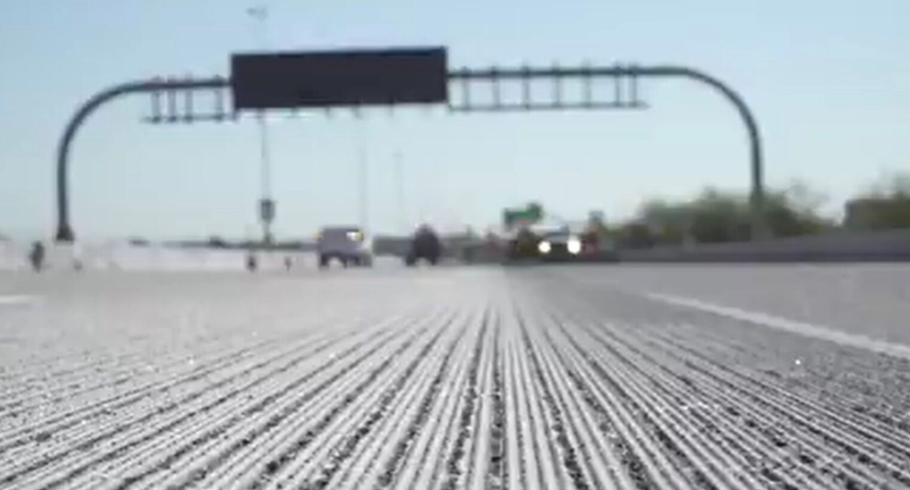
Traffic noise from the recently widened Loop 101/Price Freeway that runs through Tempe, Chandler and Mesa has been among the hot-button local-news topics thus far in 2021.
Before widening of the freeway from U.S. 60 south to Loop 202, which was completed last September, the freeway was topped with an inch-thick layer of rubberized asphalt.
There were very few noise complaints from neighbors living within a half-mile of the freeway.
The bulk of the metro Phoenix freeway system has a rubberized-asphalt top layer, which reduces traffic noise, however that surface has reached or exceeded its projected life cycle on many miles of the system. Rubberized asphalt is expensive to replace and there is no funding source to pay for it.
That sent Arizona Department of Transportation and Maricopa Association of Governments searching for a less-expensive freeway surface that also mitigates noise from traffic.
The widened segment of Loop 101 is finished with a technique known as diamond grinding, in which a machine cuts grooves into the concrete finish in an attempt to reduce noise. This is less expensive than rubberized asphalt and is said to have a considerably longer life cycle.
Neighbors, however, have found the resulting noise from the diamond-grind surface to be unbearable. Nearly 300 complaints have been lodged, some accompanied by photos or videos showing noise readings on hand-held readers registering more than 70 decibels, well above the federal and ADOT acceptable level of 65 decibels.
ADOT, however, maintains that its readings show levels generally in the 50-decibel range, well within standards and similar to those taken in similar locations before widening when the stretch was topped with rubberized asphalt.
It’s a wide disconnect.
Accordingly, at the request of Tempe Mayor Corey Woods, the MAG Transportation Policy Committee and ADOT in late February agreed to have an independent third party take noise readings and study noise from the freeway.
In a letter to the editor of Wrangler News in February, Tempe resident Dr. Donald Boles posed several questions regarding diamond grinding and how it came to be used on the widened Price Freeway.

Daina Mann, assistant communications director of ADOT, responds to Dr. Boles’ questions here:
Question: Were procedures followed to get community input prior to this “experiment”?
Answer: The diamond grinding pilot program was approved through the Maricopa Association of Governments’ public process, which included presentations to MAG’s Management Committee, Transportation Policy Committee and Regional Council, who approved the pilot in June 2020. Each of those meetings was public and a notice was provided with an opportunity for public comment. MAG is the metropolitan planning organization for the region and comprises 27 cities and towns, 3 Native nations, Maricopa County, Pinal County and ADOT. The Regional Council is the governing and policy-making body for MAG and is composed of elected officials appointed from each member agency.
Q: Were the deciding ADOT officials free of vendor bias or incentives to take this course?
A: Yes. ADOT, in partnership with MAG, studied several concrete-based, surface-treatment alternatives, ultimately recommending the diamond-grind treatment alternative for this pilot program. The pilot program was approved by the MAG Regional Council on June 24, 2020. The two projects that have been diamond ground to date have different contractors performing the work.
Q: Was the contracting work for surfacing open to competitive bidding?
A: Yes, through a project-delivery process. The bids for the Loop 101/Price Freeway and Loop 101/Pima Freeway construction projects were secured through a “design build” project-delivery process, whereby designers and contractors join together as a team to bid on a project. Diamond-grind contractors are subcontractors on those teams. The contracts for design-build contractors are competitively procured through ADOT through the design-build process.
Q: Were the sound-level measurements properly executed by an impartial, expert third party?
A: The noise measurements along Loop 101/Price Freeway were performed by ADOT’s professional staff and non-ADOT technical experts. Measurement procedures and methodologies were performed using federal guidelines and standards.
Q: Were the sound-level measurements taken from second-story windows as well as ground level?
A: No, in accordance with federal guidelines for performing noise measurements, ADOT conducted readings in yards and patios in areas at the edge of ADOT’s right of way.
Q: Did it include continuous peak-level monitoring for 24-72 hours?
A: In accordance with federal guidelines for noise measurements, ADOT took multiple noise readings for a duration of 10 minutes each. We do not conduct continuous noise monitoring as this is not an accepted methodology for freeway-noise measurements.
Q: Was sound volume averaging used?
A: Yes, ADOT’s reported noise-level readings are based on the LeQ, or weighted average of the noise level, during each testing period.
Q: What are the background frequencies and waveforms observed?
A: We are not sure we understand the question. Background noise may be a result of a number of activities occurring in the area, such as airplane overflight, landscaping activities or traffic on arterial or neighborhood streets. Field measurements in the neighborhoods included all noise sources, the freeway noise and any other activity present at the time of the measurements.
Q: Are there special frequencies and waveforms characteristic of this surface treatment?
A: No special characteristics have been observed.
Q: If the Wrangler News newspaper states that sporadic measurements taken by ADOT were only 2dB below the established objectionable level, and many residents with mobile digital apps were recording higher levels, would it not be indicated to check veracity, calibration and make further measurements?
A: ADOT and our noise-consultant experts use sophisticated, factory-calibrated noise-monitoring equipment approved for use by the Federal Highway Administration. This equipment was used to measure noise levels in locations where residents were reporting higher levels through smartphone noise-monitoring applications.
Q: Are the towns bordering this “experiment” also liable for the damages this “experiment” will cause for diminished property values, and will property taxes be downwardly adjusted to reflect these changes? If so, how will community services be impacted?
A: Our findings indicate that the current noise levels are below federal and ADOT thresholds, and that readings are comparable to those taken in 2013 with rubberized asphalt. Properties in proximity to a freeway can expect to have some level of noise. There is no state or federal statute that compensates property owners for freeway noise or roadway noise.
Q: What measures of noise abatement are under consideration to ameliorate this failed “experiment”?
A: Current noise levels are verified to be below ADOT and federal thresholds to consider additional noise-abatement measures.
Q: Will the public be part of the decision process for which noise-abatement method is used?
A: In coordination with MAG and its policymakers, diamond grinding will be evaluated based on three characteristics: ride quality, sound levels and lifecycle costs. Public feedback also will be considered.
Does your business serve South Tempe or West Chandler? Wrangler News/wranglernews.com advertisements get results! To purchase a print or online ad, dial 480-966-0837. Got a story idea or news tip? Give us a call at 480-966-0837.



“Rubberized asphalt is expensive to replace and there is no funding source to pay for it.”
They recently had the funding for the highway to nowhere South Mountain Freeway, the ” most expensive highway project in AZ history.”
I wouldn’t trust an ADOT crew to do a fair study as far as I could throw one of their bulldozers. Get it redone by an independent group. This is especially important because most of the Price Freeway is below grade and the results can be easily manipulated.
I’m curious as to what diamond-grind finish does to a downed motorcyclist sliding across it at 70mph in comparison to rubberized and standard.
It’s ridiculously more noisy since the Loop 101 widening up on the north side of Phoenix between 7th Avenue and
I-17, too. The rubberized asphalt was much more effective against noise.